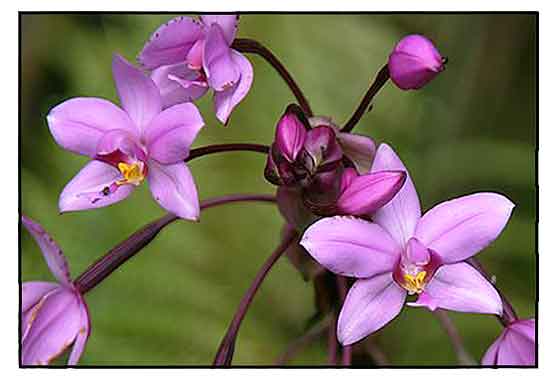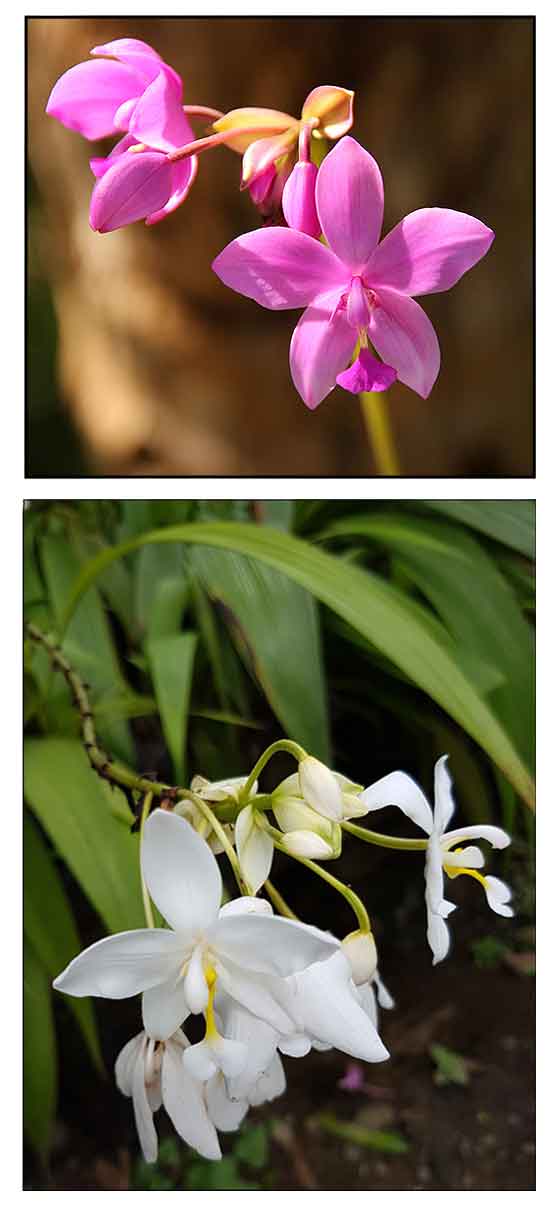
Family • Orchidaceae
Philippine ground orchid
Spathoglottis plicata Blume
LARGE PURPLE ORCHID
| Scientific names | Common names |
| Bletia angustifolia Gaudich. | Common spathoglottis (Engl.) |
| Calanathe poilanei Gagnep. | Large purple orchid (Engl.) |
| Paxtonia rosea Lindl. | Malayan ground orchid (Engl.) |
| Phaius rumphii Blume | Philippine ground orchid (Engl.) |
| Spathoglottis angustifolia (Gaudich.) Benth. & Hook.f. | Philippine orchid (Engl.) |
| Spathoglottis angustorum Rchb.f. | Pleated leaf spathoglottis (Engl.) |
| Spathoglottis daenikeri Kraenzl. | Spathoglottis orchid (Engl.) |
| Spathoglottis deplanchei Rchb.f. | |
| Spathoglottis grandifolia Schltr. | |
| Spathoglottis lilacina Griff. | |
| Spathoglottis papuana var. puberiflora Rogers & White | |
| Spathoglottis papuana var. puberula Schltr. | |
| Spathoglottis plicata Blume | |
| Spathoglottis plicata f. alba (Ridl.) N.H.Tuan & O.Gruss | |
| Spathoglottis plicata f. alba N.H.Tuan & O.Gruss | |
| Spathoglottis plicata var. alba Ridl. | |
| Spathoglottis plicata var. minahassae Schltr. | |
| Spathoglottis rosea (Lindl.) G.Nicholson | |
| Spathoglottis spicata Lindl. | |
| Spathoglottis vieillardii Rchb.f. | |
| Spathoglottis wariana Schltr. | |
| Spathoglottis plicata Blume is an accepted species. KEW: Plants of the World Online | |
| Other vernacular names |
| CHINA: San zi tong. |
| INDONESIA: Anggrek songkok. |
| OTHERS: Lumbah tikus. |
April 2024
![]()
 |
| PHOTOS / ILLUSTRATIONS |
| IMAGE SOURCE: Spathoglottis plicata / Island of Fatu Iva, Marquesas Is., French Polynesia / Sémhur / CC BY-SA 3.0 / Click on image or link to go to source page / Wikipedia |
| OTHER IMAGE SOURCE: Spathoglottis plicata flower detail / Swardeepak / CC BY-SA 4.0 / Click on image or link to go to source page / Wikipedia |
| OTHER IMAGE SOURCE: Spathoglottis plicata / White cultivar from Bukidnon / Obsidian Soul / CC0 / Click on image or link to go to source page / Wikipedia |
Additional
Sources and Suggested Readings |
• |
DOI: It is not uncommon for links on studies/sources to change. Copying and pasting the information on the search window or using the DOI (if available) will often redirect to the new link page. (Citing and Using a (DOI) Digital Object Identifier) |
| List of Understudied Philippine Medicinal Plants |
| New plant names needed The compilation now numbers over 1,300 medicinal plants. While I believe there are hundreds more that can be added to the collection, they are becoming more difficult to find. If you have a plant to suggest for inclusion, native or introduced, please email the info: scientific name (most helpful), local plant name (if known), any known folkloric medicinal use, and, if possible, a photo. Your help will be greatly appreciated. |
• |
 |


 • Medium to large terrestrial orchid commonly found in Singapore. Foliage: Long, straplike leaves are light green and pleated. Flowers: Pinkish purple, odorless flowers occur in groups of 5 - 30 and open a few at a time (4 cm wide). Flowers are composed of 1 dorsal sepal, 2 petals, 2 lateral sepals and a lip which are all pinkish purple. The terminal inflorescence is borne on a long stalk reaching up to 1.5 - 2 m in length. This species is free flowering. Fruit: Seed pod is light green and cylindrical. (
• Medium to large terrestrial orchid commonly found in Singapore. Foliage: Long, straplike leaves are light green and pleated. Flowers: Pinkish purple, odorless flowers occur in groups of 5 - 30 and open a few at a time (4 cm wide). Flowers are composed of 1 dorsal sepal, 2 petals, 2 lateral sepals and a lip which are all pinkish purple. The terminal inflorescence is borne on a long stalk reaching up to 1.5 - 2 m in length. This species is free flowering. Fruit: Seed pod is light green and cylindrical. (